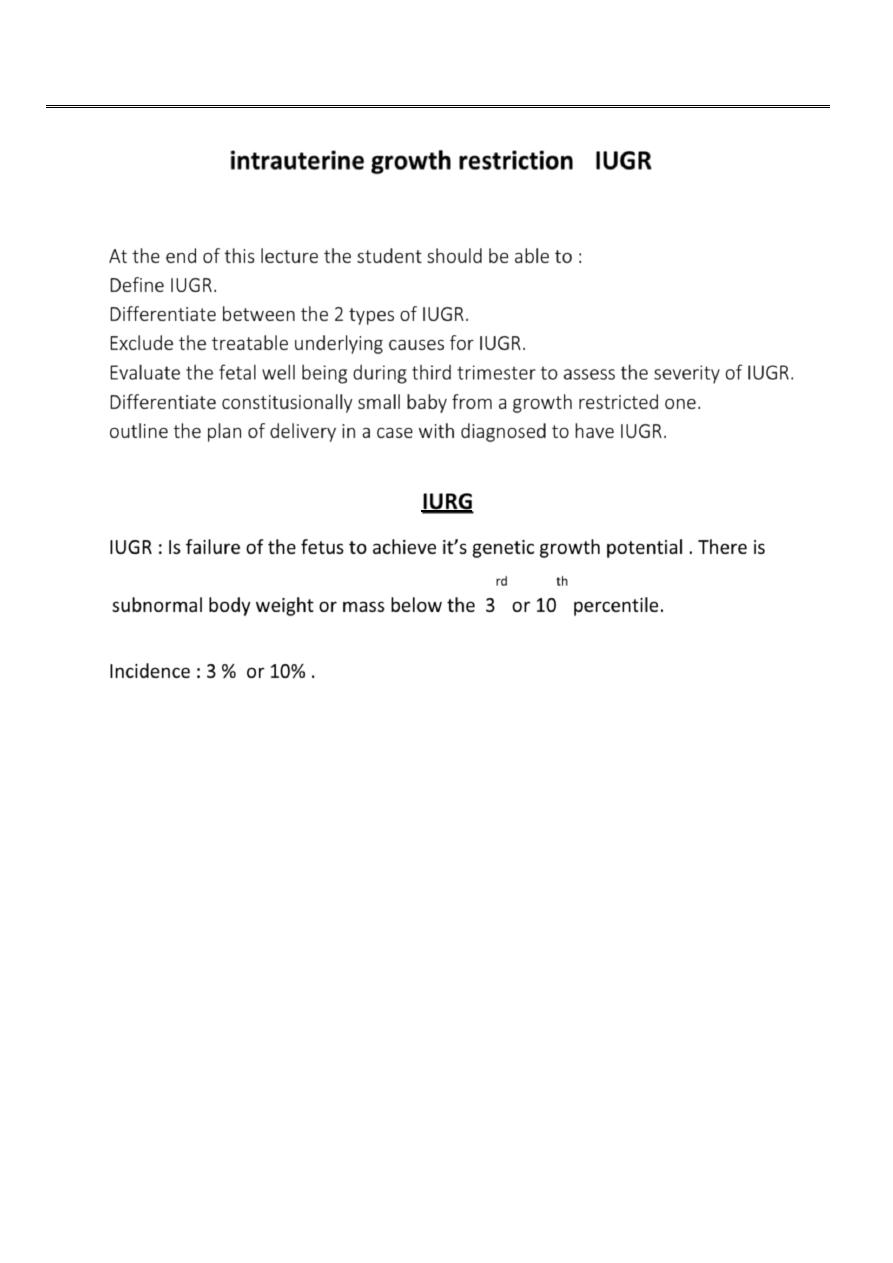
1
4th stage
Obstetrics
Lec-
Dr.Asmaa
9/3/2016
(
)
intrauterine growth restriction IUGR
At the end of this lecture the student should be able to :
Define IUGR.
Differentiate between the 2 types of IUGR.
Exclude the treatable underlying causes for IUGR.
Evaluate the fetal well being during third trimester to assess the severity of IUGR.
Differentiate constitusionally small baby from a growth restricted one.
outline the plan of delivery in a case with diagnosed to have IUGR.
IURG
IUGR : Is failure of the fetus to achieve it’s genetic growth potential . There is
subnormal body weight or mass below the 3
rd
or 10
th
percentile.
Incidence : 3 % or 10% .
IUGR :
Fetal factors:
1. Infection
2. Heart disease
3. Malformation
4. Chromosomal abnormality
Maternal factors:
1. Cardiorespiratory dis.
2. Renal disease
3. Anemia, fever
4. Drugs (DES, anti cancer, narcotics)
5. Smoking, alcohol
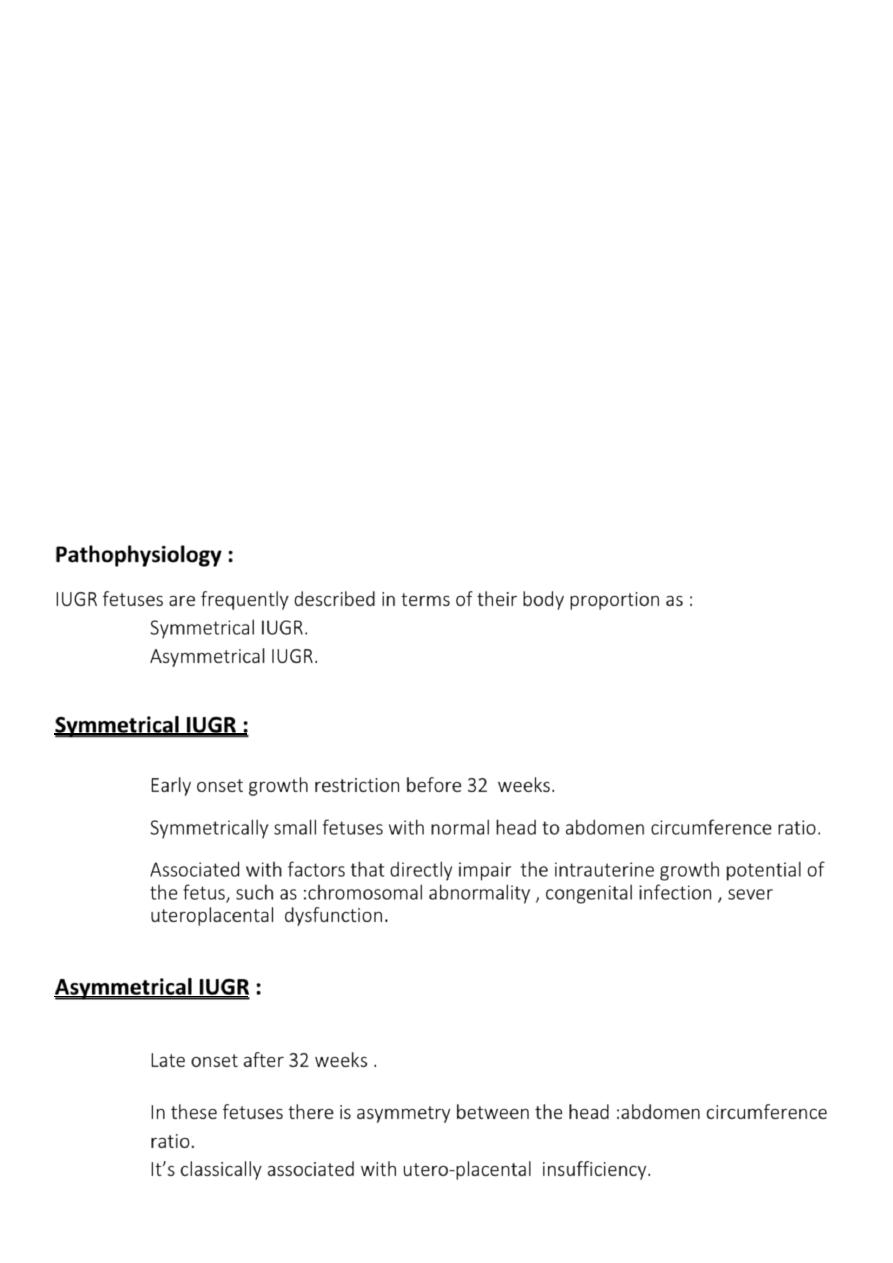
2
Placental factors:
1. Abruptio, placenta previa
2. Thrombosis, infarction
3. Inflammation
4. chorioamnionitis
5. placental cyst, chorioangioma
Uterine factors :
1. decreased UPflow
2. C.T disorder
3. Chronic hypertention
4. PE, DM
5. Fibromyoma
6. Morphologic abnormality of placenta
Pathophysiology :
IUGR fetuses are frequently described in terms of their body proportion as :
Symmetrical IUGR.
Asymmetrical IUGR.
Symmetrical IUGR :
Early onset growth restriction before 32 weeks.
Symmetrically small fetuses with normal head to abdomen circumference ratio.
Associated with factors that directly impair the intrauterine growth potential of
the fetus, such as :chromosomal abnormality , congenital infection , sever
uteroplacental
dysfunction.
Asymmetrical IUGR :
Late onset after 32 weeks .
In these fetuses there is asymmetry between the head :abdomen circumference
ratio.
It’s classically associated with utero-placental insufficiency.
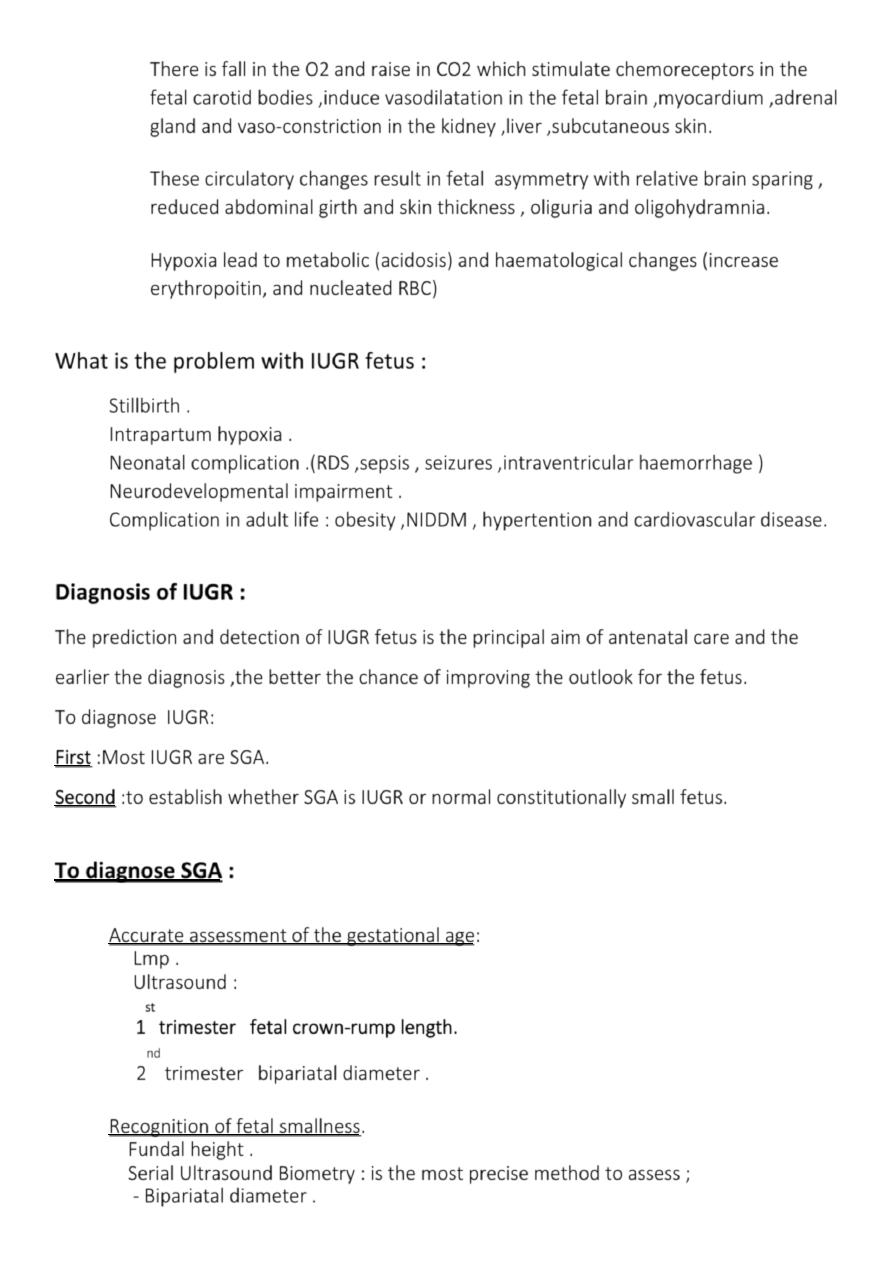
3
There is fall in the O2 and raise in CO2 which stimulate chemoreceptors in the
fetal carotid bodies ,induce vasodilatation in the fetal brain ,myocardium ,adrenal
gland and vaso-constriction in the kidney ,liver ,subcutaneous skin.
These circulatory changes result in fetal asymmetry with relative brain sparing ,
reduced abdominal girth and skin thickness , oliguria and oligohydramnia.
Hypoxia lead to metabolic (acidosis) and haematological changes (increase
erythropoitin, and nucleated RBC)
What is the problem with IUGR fetus :
1.
Stillbirth .
2.
Intrapartum hypoxia .
3.
Neonatal complication .(RDS ,sepsis , seizures ,intraventricular haemorrhage )
4.
Neurodevelopmental impairment .
5.
Complication in adult life : obesity ,NIDDM , hypertention and cardiovascular disease.
Diagnosis of IUGR :
The prediction and detection of IUGR fetus is the principal aim of antenatal care and the
earlier the diagnosis ,the better the chance of improving the outlook for the fetus.
To diagnose IUGR:
First :Most IUGR are SGA.
Second :to establish whether SGA is IUGR or normal constitutionally small fetus.
To diagnose SGA :
Accurate assessment of the gestational age:
Lmp .
Ultrasound :
1
st
trimester fetal crown-rump length.
2
nd
trimester bipariatal diameter .
Recognition of fetal smallness.
Fundal height .
Serial Ultrasound Biometry : is the most precise method to assess ;
- Bipariatal diameter .
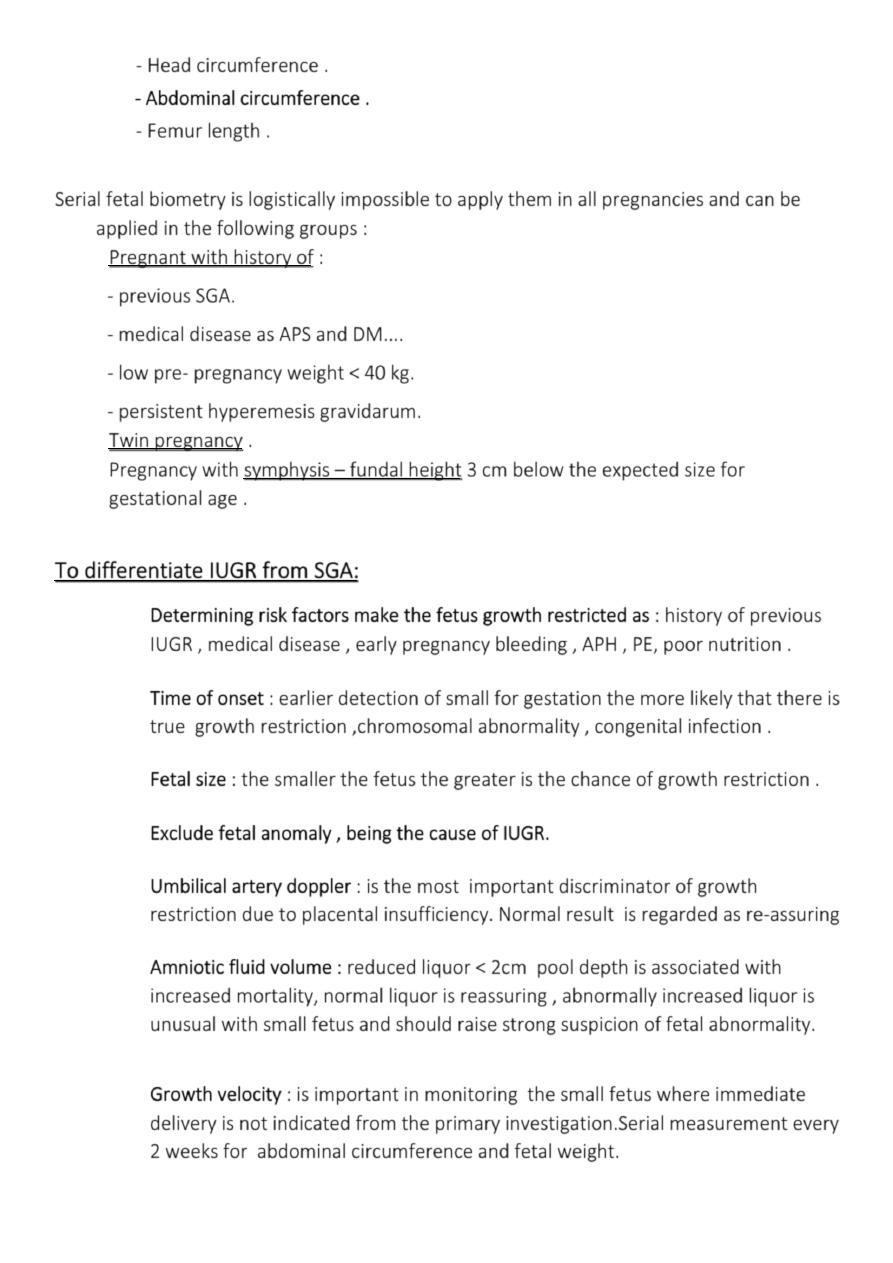
4
- Head circumference .
- Abdominal circumference .
- Femur length .
Serial fetal biometry is logistically impossible to apply them in all pregnancies and can be
applied in the following groups :
Pregnant with history of :
- previous SGA.
- medical disease as APS and DM....
- low pre- pregnancy weight < 40 kg.
- persistent hyperemesis gravidarum.
Twin pregnancy .
Pregnancy with symphysis – fundal height 3 cm below the expected size for
gestational age .
To differentiate IUGR from SGA:
Determining risk factors make the fetus growth restricted as : history of previous
IUGR , medical disease , early pregnancy bleeding , APH , PE, poor nutrition .
Time of onset : earlier detection of small for gestation the more likely that there is
true growth restriction ,chromosomal abnormality , congenital infection .
Fetal size : the smaller the fetus the greater is the chance of growth restriction .
Exclude fetal anomaly , being the cause of IUGR.
Umbilical artery doppler : is the most important discriminator of growth
restriction due to placental insufficiency. Normal result is regarded as re-assuring
Amniotic fluid volume : reduced liquor < 2cm pool depth is associated with
increased mortality, normal liquor is reassuring , abnormally increased liquor is
unusual with small fetus and should raise strong suspicion of fetal abnormality.
Growth velocity : is important in monitoring the small fetus where immediate
delivery is not indicated from the primary investigation.Serial measurement every
2 weeks for abdominal circumference and fetal weight.
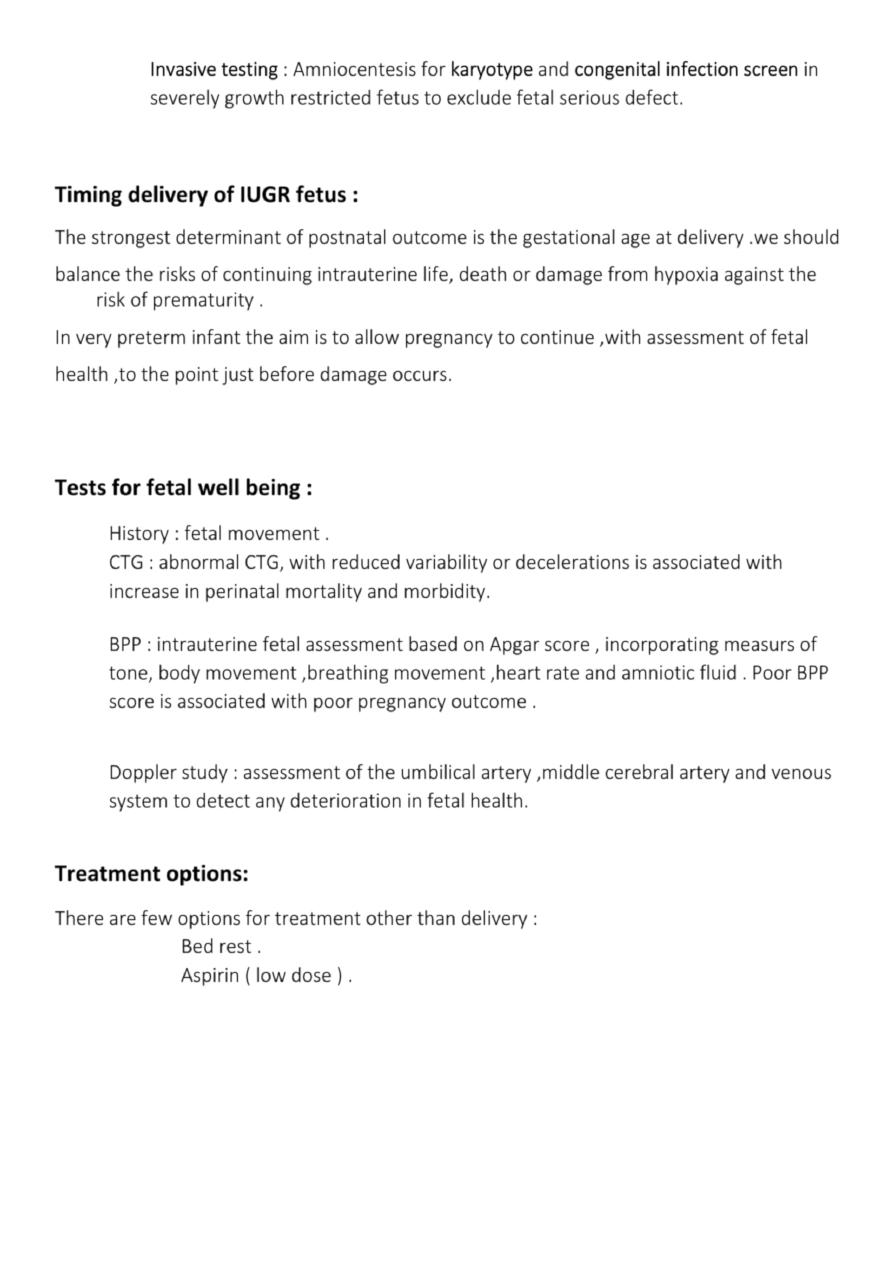
5
Invasive testing : Amniocentesis for karyotype and congenital infection screen in
severely growth restricted fetus to exclude fetal serious defect.
Timing delivery of IUGR fetus :
The strongest determinant of postnatal outcome is the gestational age at delivery .we should
balance the risks of continuing intrauterine life, death or damage from hypoxia against the
risk of prematurity .
In very preterm infant the aim is to allow pregnancy to continue ,with assessment of fetal
health ,to the point just before damage occurs.
Tests for fetal well being :
History : fetal movement .
CTG : abnormal CTG, with reduced variability or decelerations is associated with
increase in perinatal mortality and morbidity.
BPP : intrauterine fetal assessment based on Apgar score , incorporating measurs of
tone, body movement ,breathing movement ,heart rate and amniotic fluid . Poor BPP
score is associated with poor pregnancy outcome .
Doppler study : assessment of the umbilical artery ,middle cerebral artery and venous
system to detect any deterioration in fetal health.
Treatment options:
There are few options for treatment other than delivery :
Bed rest .
Aspirin ( low dose ) .
